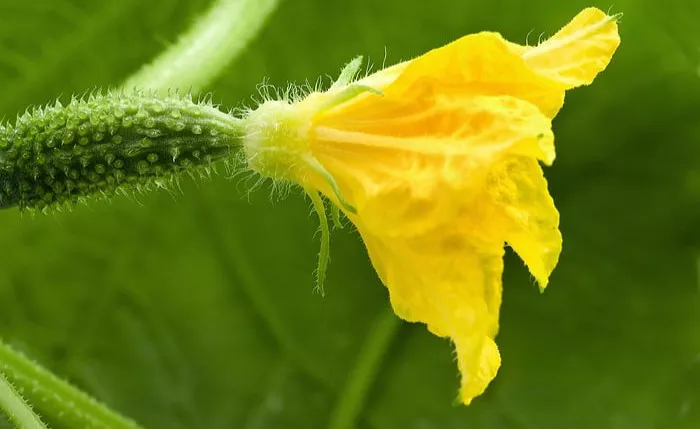Cucumber flowers are an essential part of the cucumber plant’s life cycle, playing a crucial role in reproduction and fruit production. Understanding their structure, types, and functions can help gardeners and botanists alike appreciate the complexity and beauty of these plants. In this article, we will explore the appearance, types, and significance of cucumber flowers in detail.
The Structure of Cucumber Flowers
Cucumber flowers, like all flowers, have a specific structure that includes several key parts. These parts work together to facilitate pollination and fertilization, leading to the production of cucumbers.
Pedicel and Receptacle
The pedicel is the stalk that supports the flower and connects it to the main stem of the plant. The receptacle is the base of the flower where all other parts are attached. In cucumber flowers, the receptacle is often slightly swollen and serves as the foundation for the rest of the flower’s structure.
Calyx and Corolla
The calyx is the outermost part of the flower, consisting of small, leaf-like structures called sepals. These sepals protect the flower bud before it opens. In cucumber flowers, the sepals are usually green and can be slightly pointed.
Inside the calyx is the corolla, which is made up of petals. Cucumber flowers typically have five petals that are yellow in color. These petals are often fused at the base, forming a tube-like structure that opens up into a star shape. The bright yellow color of the petals helps attract pollinators like bees and other insects.
Stamen and Pistil
The stamen is the male reproductive part of the flower, consisting of a filament and an anther. The anther produces pollen, which is necessary for fertilization. In cucumber flowers, the stamens are usually located in the center of the flower and are surrounded by the petals.
The pistil is the female reproductive part, consisting of the ovary, style, and stigma. The ovary contains the ovules, which will develop into seeds once fertilized. The style is a slender stalk that connects the ovary to the stigma, which is the sticky surface that captures pollen. In cucumber flowers, the pistil is often located in the center, surrounded by the stamens.
Types of Cucumber Flowers
Cucumber plants produce two main types of flowers: male flowers and female flowers. Understanding the differences between these two types is crucial for successful pollination and fruit production.
Male Flowers
Male cucumber flowers are typically the first to appear on the plant. They are characterized by the presence of stamens but lack a pistil. These flowers produce pollen, which is essential for fertilizing the female flowers. Male flowers are usually more numerous than female flowers and are often clustered together on the plant.
Female Flowers
Female cucumber flowers are easily identifiable by the presence of a small, immature cucumber (ovary) at the base of the flower. This ovary will develop into a cucumber once the flower is successfully pollinated. Female flowers have a pistil but lack stamens, meaning they cannot produce pollen. Instead, they rely on pollen from male flowers for fertilization.
Hermaphroditic Flowers
In some cucumber varieties, hermaphroditic flowers may occur. These flowers contain both male and female reproductive parts, allowing them to self-pollinate. However, this is less common in cucumbers, as most varieties have separate male and female flowers.
Pollination and Fertilization
Pollination is a critical step in the life cycle of cucumber flowers. Without successful pollination, the flowers will not develop into cucumbers.
Role of Pollinators
Cucumber flowers rely heavily on pollinators like bees to transfer pollen from male flowers to female flowers. The bright yellow color and sweet nectar of the flowers attract these insects, encouraging them to visit multiple flowers and facilitate cross-pollination.
Hand Pollination
In some cases, especially in greenhouses or areas with limited pollinator activity, hand pollination may be necessary. This involves manually transferring pollen from the anthers of male flowers to the stigma of female flowers using a small brush or cotton swab. This ensures that the female flowers are fertilized and can develop into cucumbers.
Factors Affecting Flower Development
Several factors can influence the development and health of cucumber flowers, including temperature, light, and nutrient availability.
Temperature
Cucumber flowers are sensitive to temperature fluctuations. High temperatures can cause male flowers to produce less pollen, while low temperatures can delay flower development. Optimal temperatures for cucumber flower development range between 70°F and 85°F (21°C to 29°C).
Light
Cucumber plants require plenty of sunlight to produce healthy flowers. Insufficient light can lead to fewer flowers and poor pollination. Ideally, cucumber plants should receive at least 6-8 hours of direct sunlight each day.
Nutrients
Proper nutrition is essential for the development of cucumber flowers. A balanced fertilizer that provides adequate amounts of nitrogen, phosphorus, and potassium can promote healthy flower production. Additionally, micronutrients like calcium and magnesium are crucial for flower and fruit development.
Conclusion
Cucumber flowers are not only beautiful but also play a vital role in the production of cucumbers. Understanding their structure, types, and the factors that affect their development can help gardeners and botanists optimize growing conditions and ensure a successful harvest. Whether you’re a seasoned gardener or a curious botanist, appreciating the intricacies of cucumber flowers can deepen your understanding of plant biology and enhance your gardening skills.


